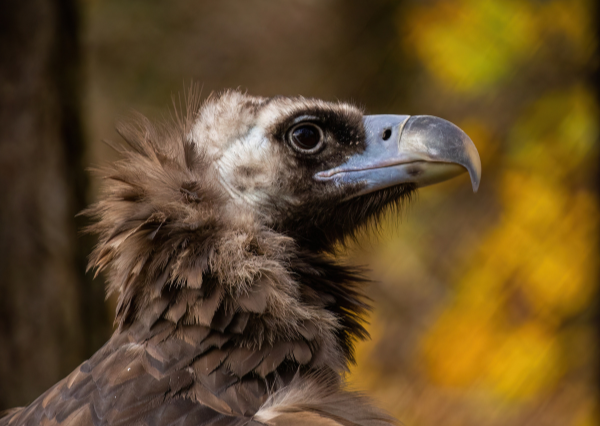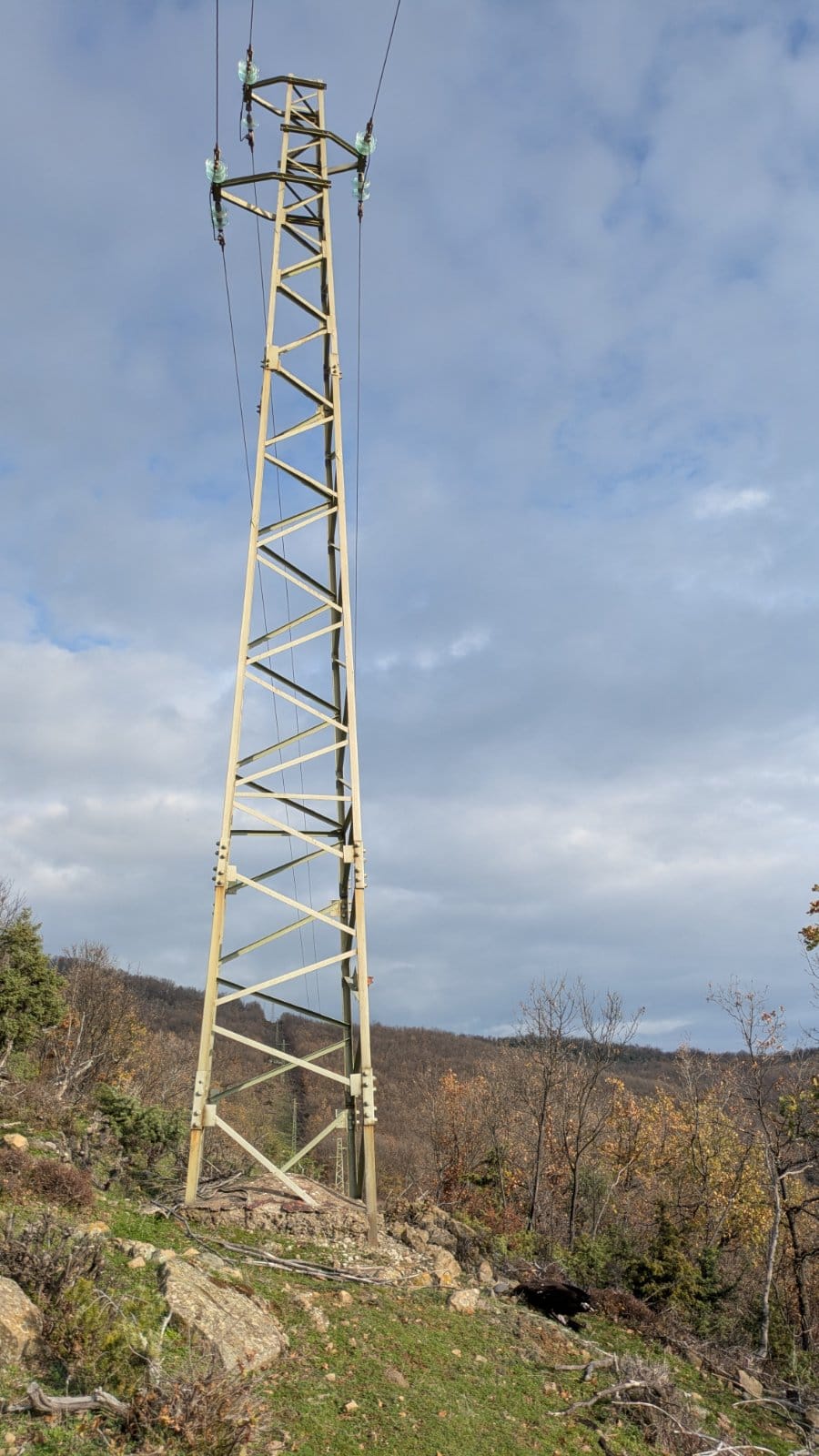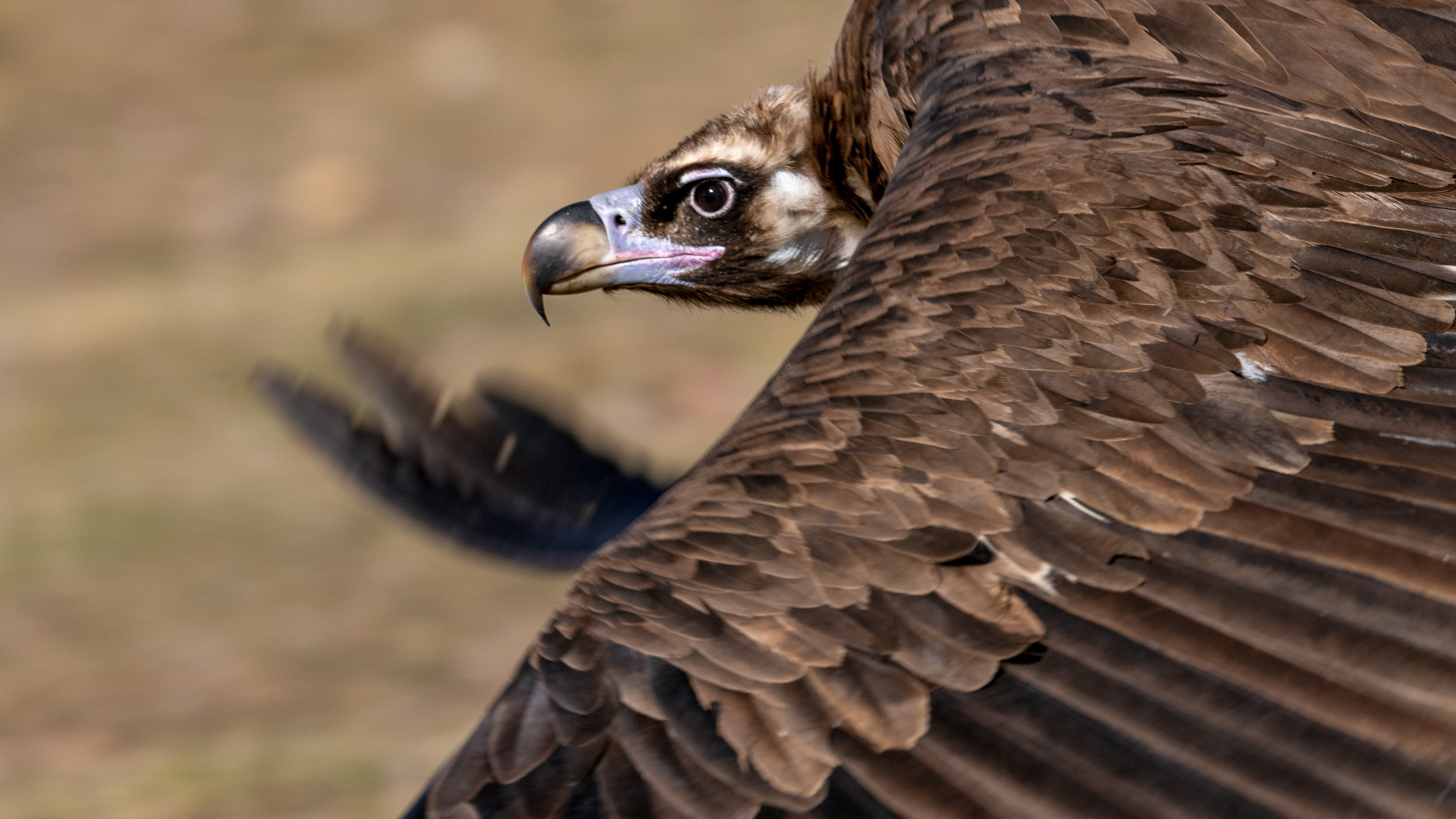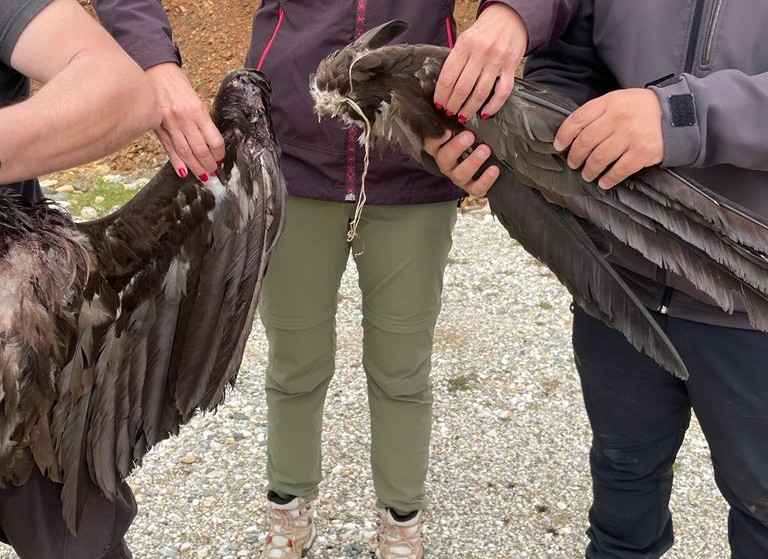Massive wildfire caused a direct and significant impact on the recovery of the species in the Nature Park, dealing a severe blow to this protected area
Two Cinereous Vulture nests from the small breeding colony in the Douro Internacional were completely destroyed by fire, while six others were damaged to varying degrees. The six Cinereous Vultures that were being held at the acclimatisation station were rescued thanks to the swift mobilisation of people and institutions, which prevented an even greater tragedy.
Institutions are now appealing for support to repair the damage.

Relentless fire
On Friday 15 August, a public holiday, while central and northern Portugal were already burning with multiple wildfires, a new blaze broke out around 1 p.m. in Poiares, in the municipality of Freixo de Espada à Cinta, right in the heart of the Douro International Natural Park (PNDI). With temperatures close to 40 °C persisting for several days, the flames spread rapidly, and within a few hours had grown into a major wildfire that extended into the neighbouring municipalities of Mogadouro and Torre de Moncorvo. In total, more than 15,000 hectares were burned, although the full extent of the damage remains uncertain.
Given the fire’s proximity to the Cinereous Vulture (Aegypius monachus) breeding colony in the PNDI, teams on the ground raised the alarm and mobilised immediately, preventing an even greater disaster.
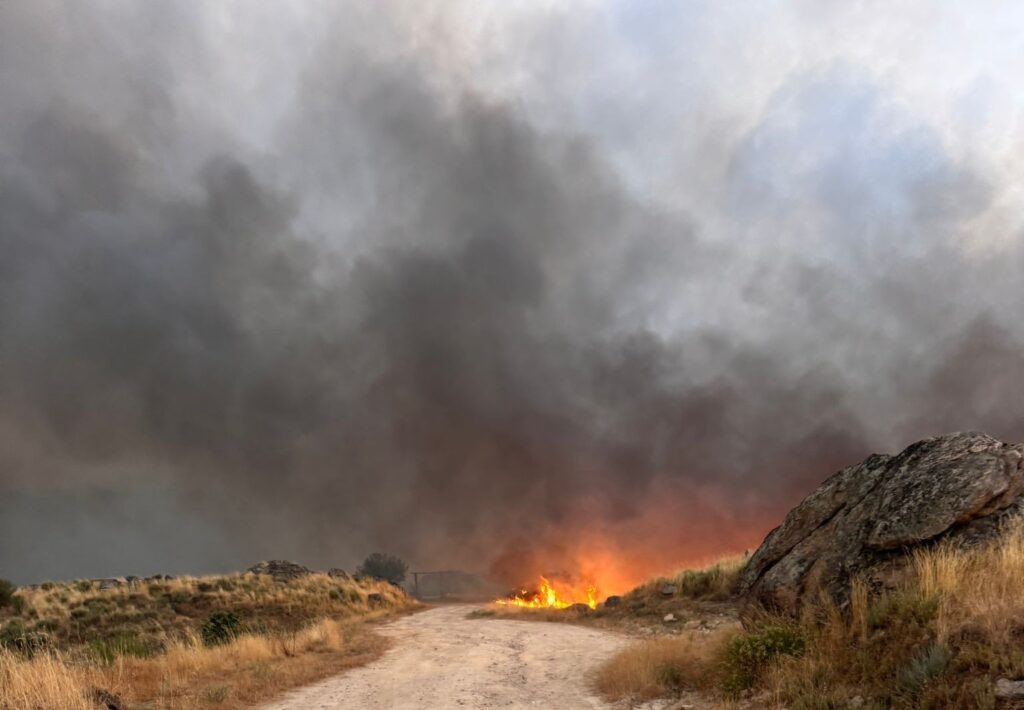
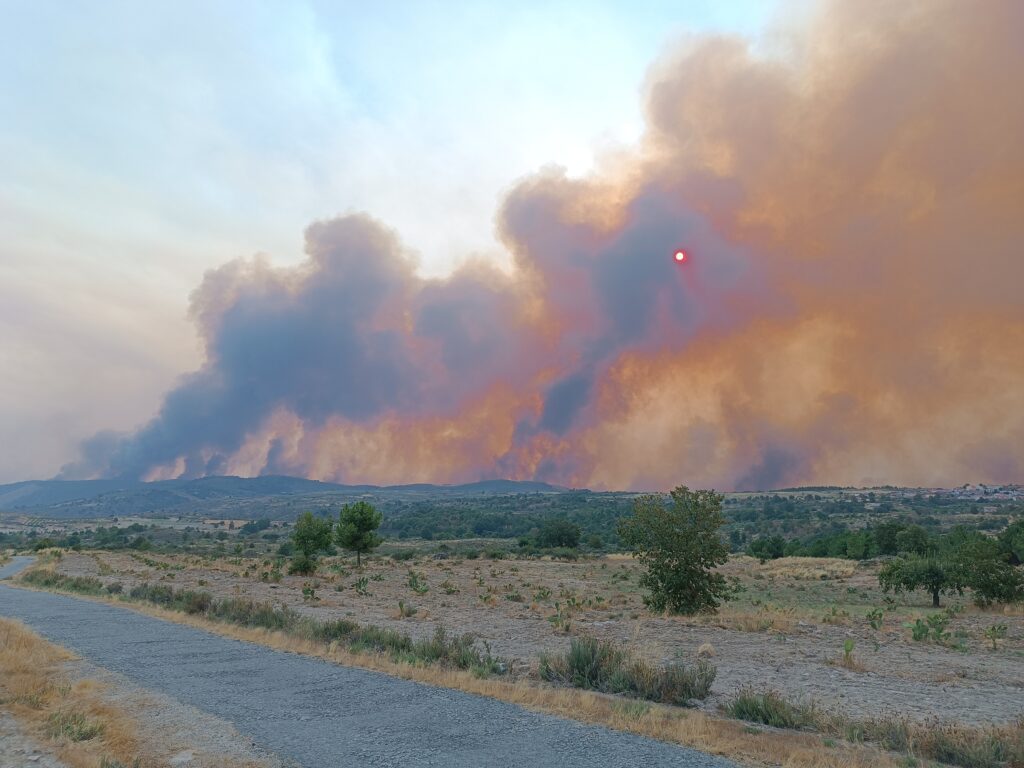
Images of the fire in the Douro Internacional Nature Park ©ICNF; Palombar
Saving vultures
On Friday evening, the fire was still far from the acclimatisation station of the LIFE Aegypius Return project, built on the Douro cliffs in Fornos. However, access to these remote areas could be cut off, which would have prevented any subsequent actions if needed. So, in a timely intervention that followed the contingency plan provided for in the project, the Palombar team, in coordination with the technicians and rangers from the Institute for Nature Conservation and Forests (ICNF/PNDI), as well as with the Vulture Conservation Foundation (VCF), Faia Brava, the livestock breeder and shepherd who looks after the property, and the veterinarians from the Veterinary Hospital of the University of Trás-os-Montes and Alto Douro (HV-UTAD), collected the six Cinereous Vultures that were in the acclimatisation aviary and transferred them to the facilities of CIARA (Centre for Environmental Interpretation and Animal Recovery), in Felgar, where they remain safe.
The rescue was the result of the careful and timely assessment made by the teams on the ground and prevented a major setback in Cinereous Vulture conservation, as the following afternoon the fire actually reached the acclimatisation station, which includes the cage, the feeding area, and the support structures.
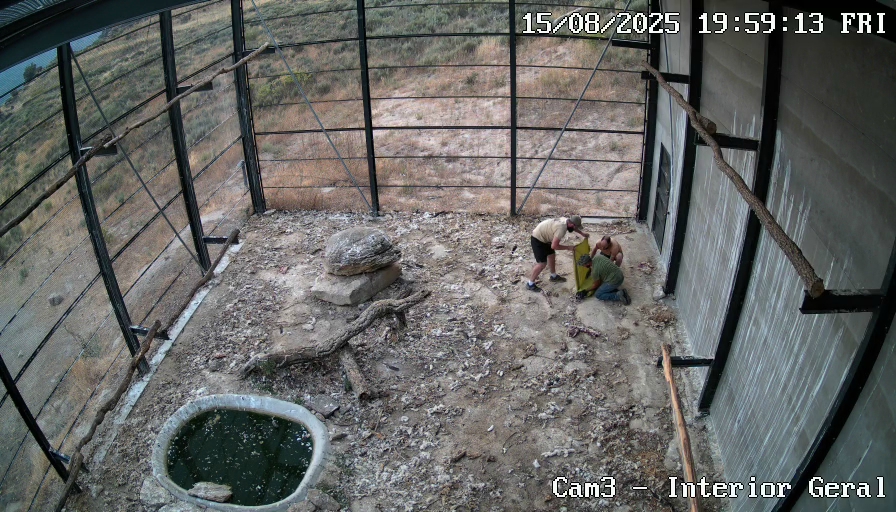
Assessing damages
Sunday morning revealed the damage caused to the acclimatisation station. Although the surrounding vegetation had been cleared over a wide area as a preventive measure implemented by Palombar under the LIFE Aegypius Return project – in accordance with the Habitat Management and Fire Risk Reduction Plan for Cinereous Vulture territories in the Douro International and Águeda Valley Special Protection Area – and was very low-growing, the fire devastated the entire habitat. The aviary sustained only minor damage, but the support container was completely destroyed. This space had functioned as both an infirmary and a digital video-surveillance centre for the facilities. The feeding area in front of the acclimatisation cage was also entirely burnt, rendering it unusable in the immediate term.
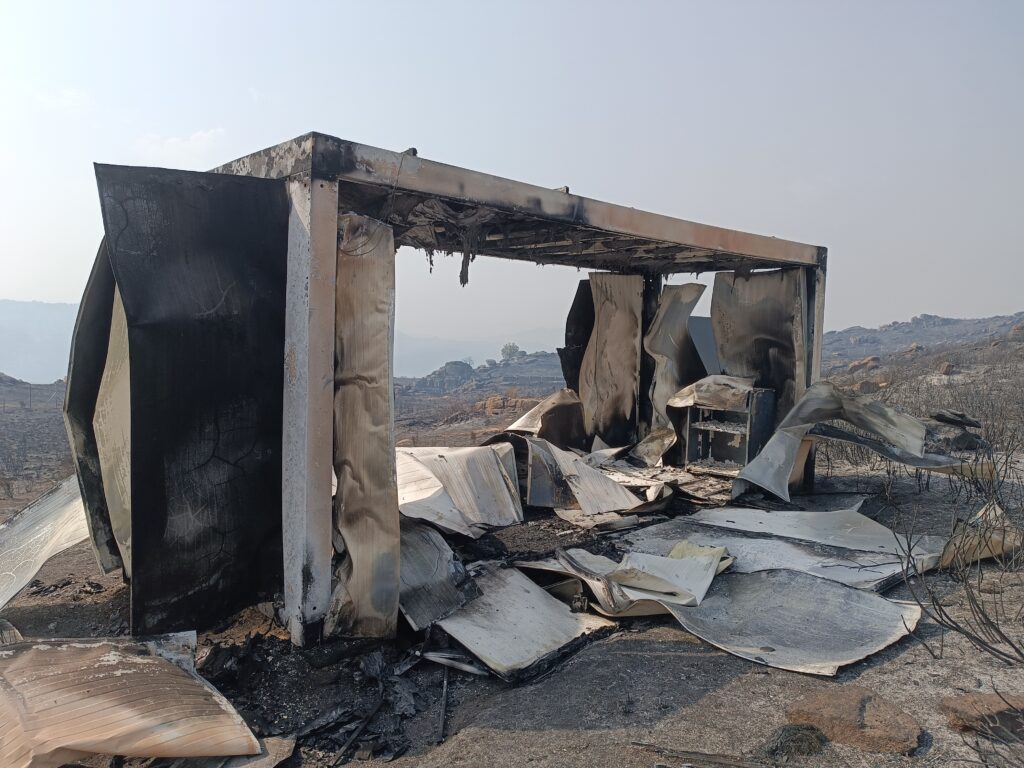
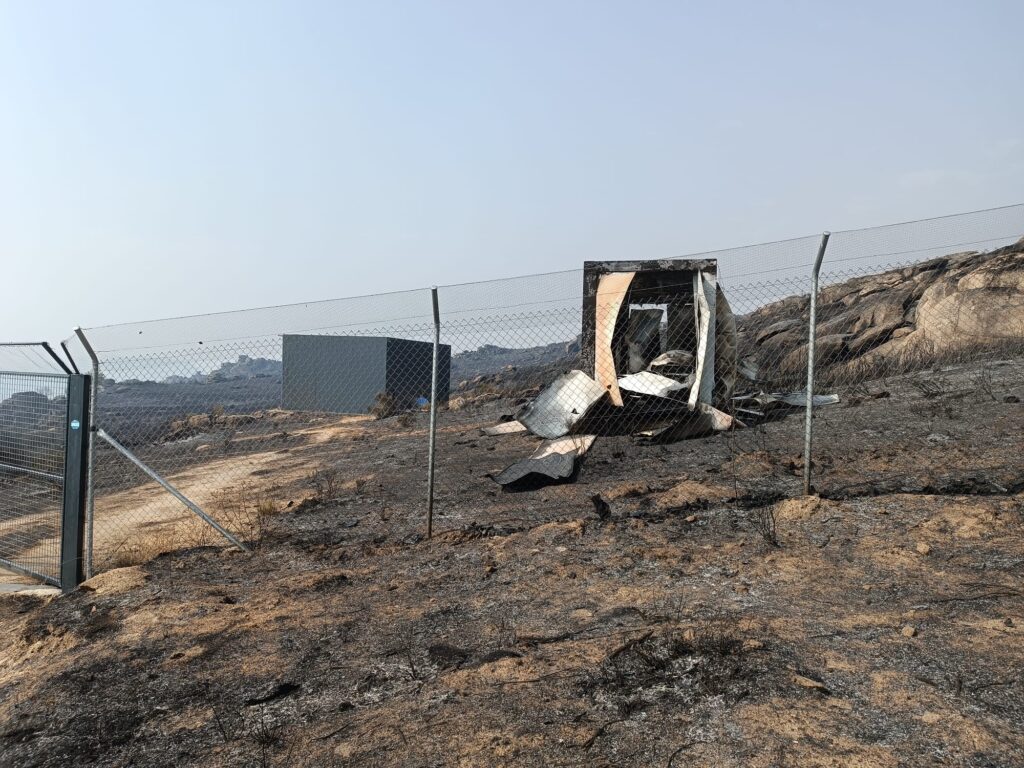
Destruction of the support container for the Cinereous Vulture acclimatisation programme. The vast extent of burnt area in the surroundings is visible. © Palombar
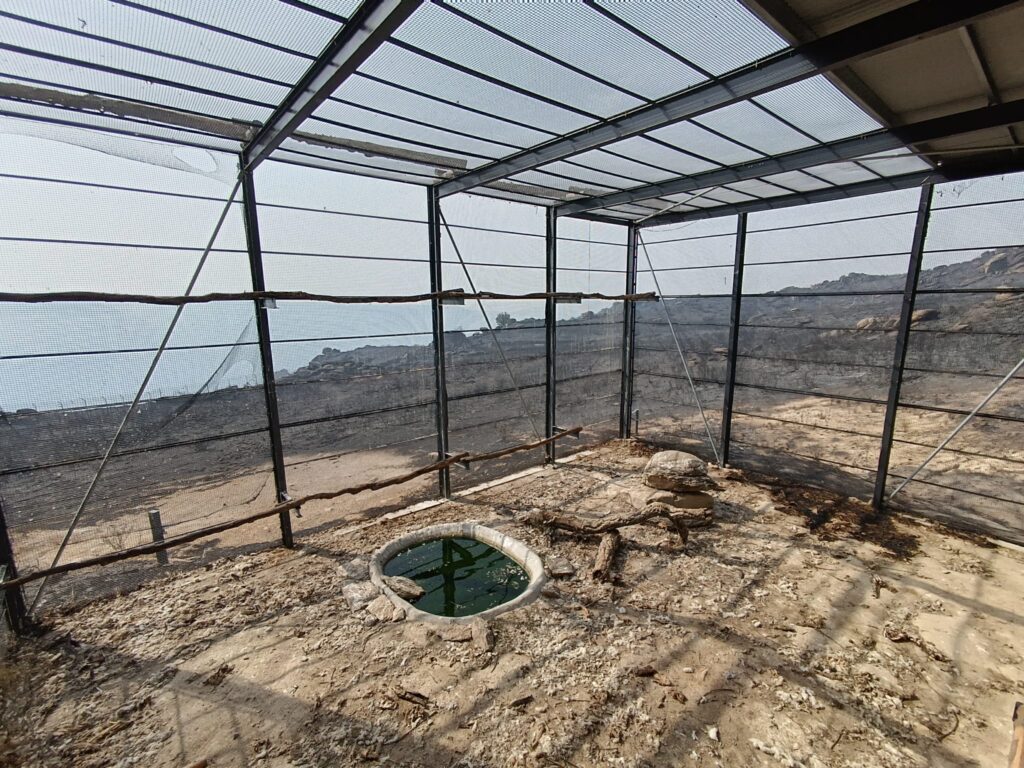
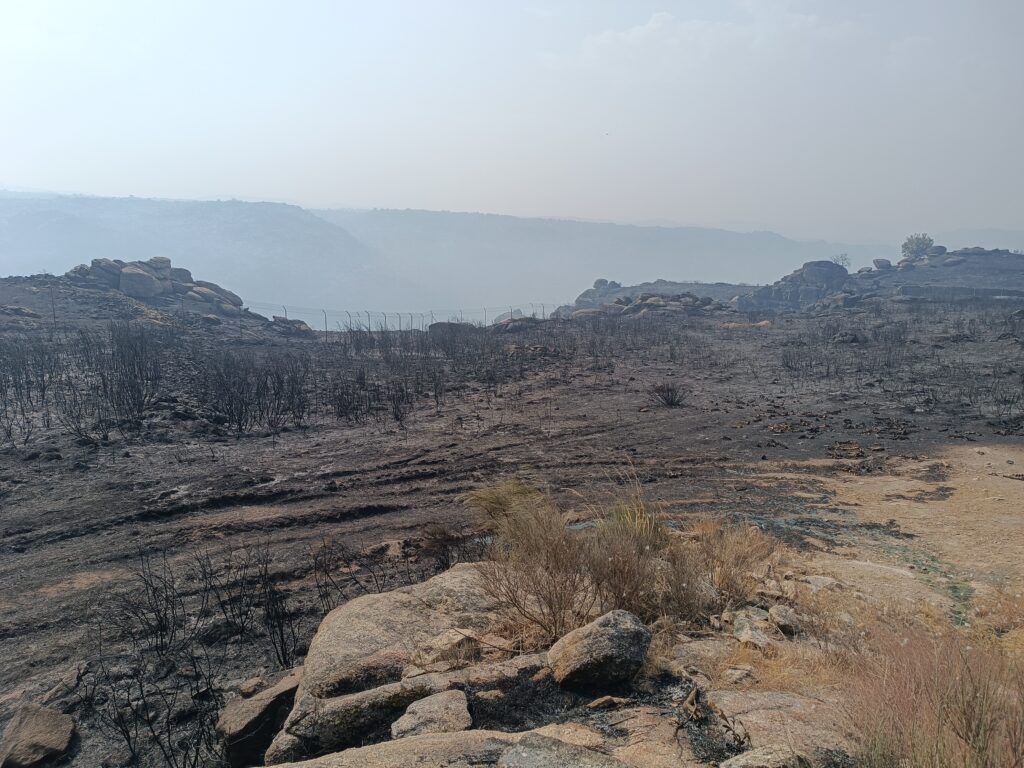
View from inside the acclimatisation aviary and the adjacent feeding area, burnt. © Palombar
Burnt nests and at least one dead chick
This year, the Cinereous Vulture colony in the Douro Internacional consisted of eight breeding pairs, five in Portugal and three on the Spanish side. A total of five chicks had developed and were being monitored by Palombar, with support from the ICNF. Four chicks had already left the nest, but one was still young and unable to fly. However, considering the age of this chick, it was expected to fledge in the following days.
When the fire and smoke allowed access to the sites, it was observed that the nest of the non-flying chick had been impacted by very close flames, and the chick was no longer in it.
During the assessment of the fire’s impact on the Cinereous Vulture colony, it was confirmed that two of the five nests that had chicks this year were completely burnt, and another two partially. Additionally, four nesting platforms previously installed to promote breeding were affected to varying degrees. One chick, tagged in June, has already been found dead. Given the very small size of the colony, this represents a major setback for its conservation, and it is possible that the adults – even if they have survived – may abandon this territory, undoing several years of efforts to restore the colony.
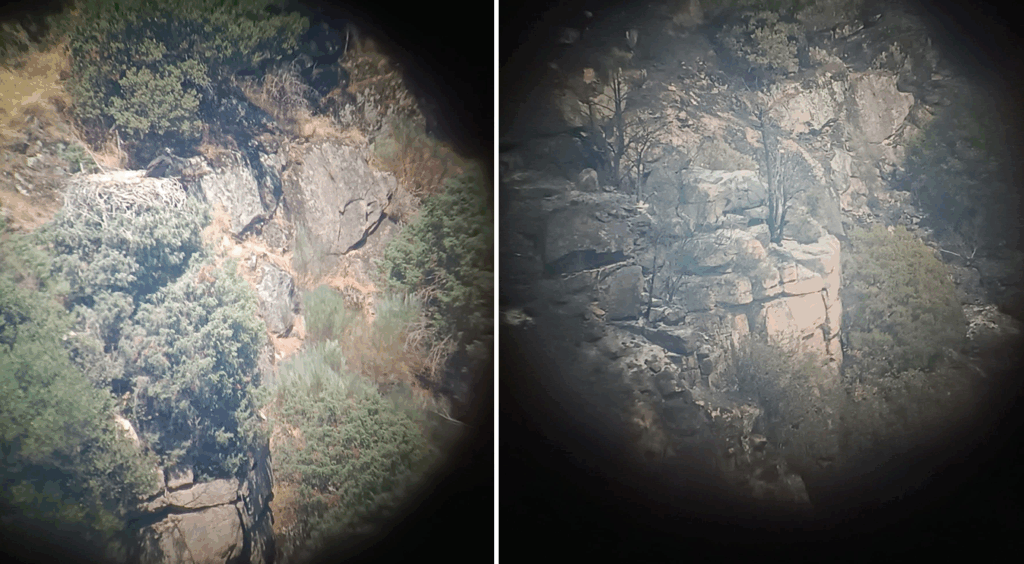
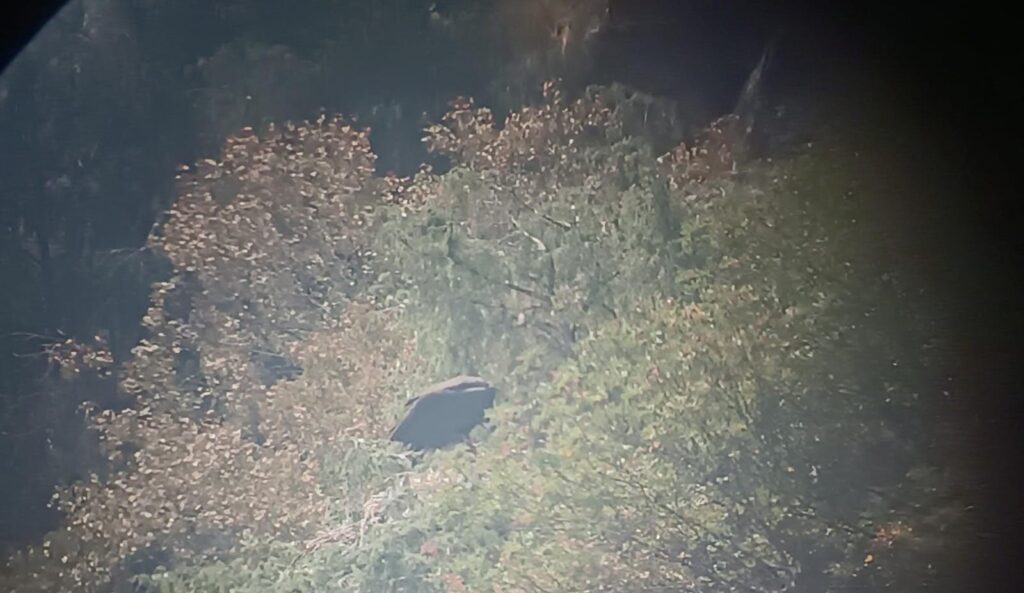
Burnt land stretching as far as the eye can see now covers the Douro cliffs and the surrounding rural and natural areas in the Freixo de Espada à Cinta land within the PNDI. The severity seems to exceed that of the 2017 fire – the year in which a Cinereous Vulture chick was carbonised – with the destruction of hundreds of hectares of breeding and feeding habitat not only for the Cinereous Vulture, but also for other endangered species such as the Egyptian Vulture (Neophron percnopterus) or the Bonelli’s Eagle (Aquila fasciata). T Restoration of this ecosystem is already underway, but it will take decades. Restoration of this ecosystem is already underway, but it will take decades.
The Cinereous Vulture colony in Douro – already the most fragile, the smallest and the most isolated in Portugal – has now suffered a severe setback, the consequences of which will be closely monitored by Palombar, Faia Brava, VCF and the competent authorities.
Acer found dead
Around 11:30 a.m. on 21/08/2025, the first chick (Acer) was confirmed dead.
It had been tagged with a GPS/GSM transmitter on 26/06/2025. Since the wildfire, the transmitter had not connected to the network and its location was unknown. Today, it sent data showing inactivity.
Palombar teams went to the site and confirmed the chick’s death. Acer did not die in the fire itself, but most likely from smoke and ash intoxication, in a slow and agonising process. The body was recovered and will undergo necropsy at the Veterinary Hospital of UTAD.
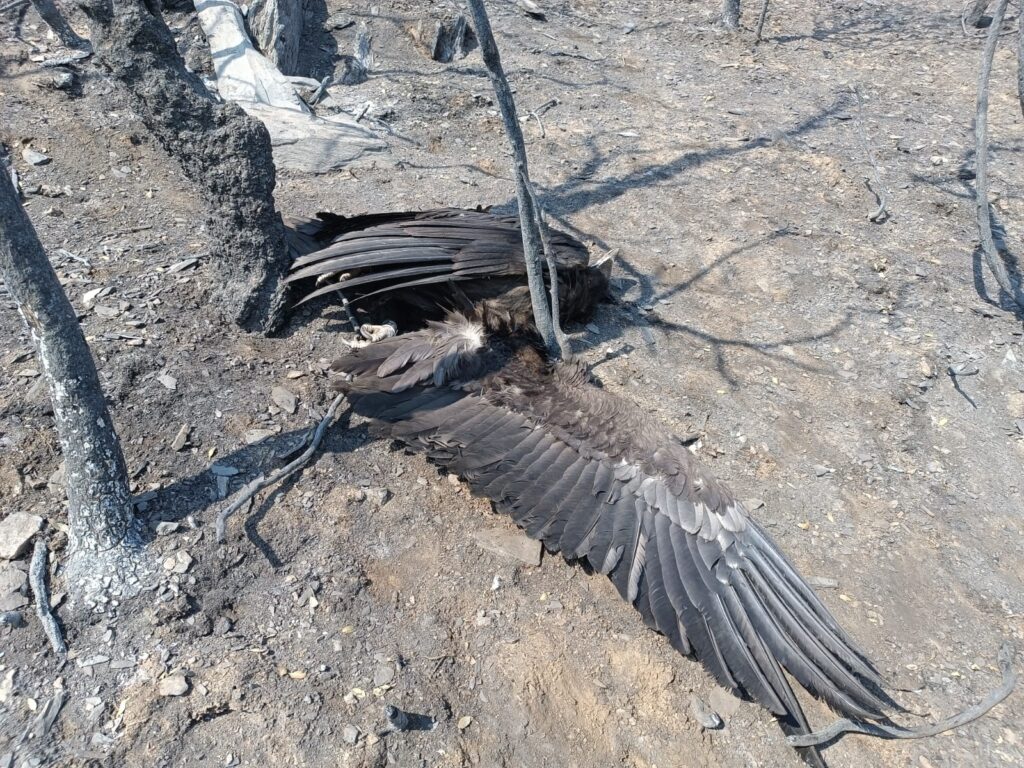
A plea for help with the next steps
Due to its fragility and isolation, the Douro Internacional colony is of strategic value for the conservation of the Cinereous Vulture in Portugal. For this reason, the LIFE Aegypius Return project has secured funding to strengthen it through a soft release programme, which promotes the establishment of breeding pairs and accelerates the colony’s expansion, strengthening connectivity and population sustainability.
The fires of the past few days have undone the results of these efforts, having destroyed extensive areas of feeding and breeding habitat, including natural nests, artificial nest platforms built under this LIFE project, the feeding area co-managed by Palombar and Faia Brava, and the acclimatisation support container, which ensured logistics and video surveillance. At the moment, the birds cannot return to these facilities, which may affect the objectives of the 2025 acclimatisation programme.
It is essential to restore the habitat around the aviary, particularly the feeding area, as well as to replace the support container. The container – which ensures surveillance of the birds in acclimatisation and their surroundings, allowing monitoring of feeding, socialisation, and interactions with wild birds – operated using solar power. The photovoltaic panels, wiring, power inverter, and other essential electronic equipment were destroyed, an investment which in 2023 amounted to 15,000 euros.
Additionally, in coordination with the Lagoaça and Fornos Parish Council and the ICNF, actions will be taken to restore priority habitats for feeding and the tranquillity of the Cinereous Vulture within the PNDI, involving extraordinary costs for which there are currently no immediate funding mechanisms.
For this reason, the LIFE Aegypius Return partners appeal to everyone’s solidarity and have launched a crowdfunding project to help restore the Cinereous Vulture conservation programme in the PNDI. Donations can be made HERE.

From hell, unity
The month of August has been marked by a veritable inferno of flames in Portugal, forcing the government to activate the European Civil Protection Mechanism and request international aid to fight the fires. This year, more than 200,000 hectares have already burned nationwide – 32,000 in the last weekend alone.
The LIFE Aegypius Return teams have been on permanent alert as fires approach the various Cinereous Vulture colonies. In addition to the Douro Internacional, the colonies at Herdade da Contenda y Serra da Malcata have also been under threat, with large fires raging nearby. On the Spanish side, the Sierra de San Pedro, in the province of Cáceres, has seen serious damage, with at least 60 Cinereous Vulture nests burnt (some still with chicks), among other significant casualties.
In all situations, the solidarity between the various institutions involved stands out – from the authorities, firefighters and non-governmental organisations to individual citizens who, even amid lives and property at risk, demonstrate unity and coordination in protecting nature and the Cinereous Vulture.
In the Douro Internacional this determination was particularly visible in the surveillance, alerts and joint action on the ground. The LIFE Aegypius Return partners, and Palombar in particular, express their gratitude for the support and action of the ICNF rangers and technicians – Northern Regional Directorate and PNDI, PNAD (JCyL), HV-UTAD and CIARA, shepherd Nelson Cordeiro, firefighters, Guarda Nacional Republicana, União das Freguesias de Lagoaça e Fornos, as well as the affected municipalities. With everyone’s support, it is now hoped that the necessary restoration of damages can be accelerated, ensuring the continued protection of the Cinereous Vulture.
About LIFE Aegypius Return

The LIFE Aegypius Return project is co-financed by the European Union’s LIFE programme. Its success depends on the involvement of all the relevant stakeholders, and the collaboration of the partners: the Vulture Conservation Foundation (VCF), the coordinating beneficiary, and the local partners Palombar – Conservação da Natureza e do Património Rural, Herdade da Contenda, Sociedade Portuguesa para o Estudo das Aves, Liga para a Protecção da Natureza, Associação Transumância e Natureza, Fundación Naturaleza y Hombre, Guarda Nacional Republicana y Associação Nacional de Proprietários Rurais Gestão Cinegética e Biodiversidade.

